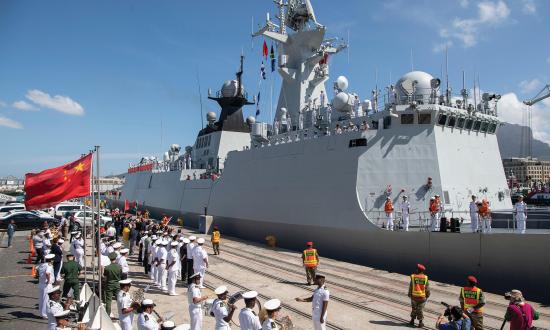Quixotic hopes that economic growth would gradually liberalize the People’s Republic of China (PRC) have given way to the reality of the Chinese Communist Party’s (CCP’s) totalitarian control, malign influence, and global hegemonic ambitions. Baked into the CCP’s narrative is antagonism toward those the Party holds responsible for China’s “century of humiliation”—namely, the United States and its allies. The 2018 National Defense Strategy (NDS) recognizes this, explicitly naming China as a long-term strategic competitor and principal priority for the Department of Defense (DoD).
The Sea Services are rapidly evolving to meet this threat, yet, competition with a CCP-led China will not be limited to the maritime or even military domain. It will require a unity of purpose that marshals the full range of national resources in concert with U.S. maritime strategy. To achieve this, the maritime strategy must be situated in a broader national strategy that articulates what a CCP-led China is doing, why it is a threat to U.S. national interests, and how the Navy–Marine Corps team can counter it. Nuance is no longer a virtue, and patience has been mistaken for weakness. The ends of U.S. maritime strategy toward a CCP-led China must be unequivocal: We win, they lose.
Maritime Strategy
The CCP has not sat idly by during the past 20 years of U.S. preoccupation in the Middle East. Its leaders seized 2000–2020 as a “period of strategic opportunity,” when international conditions would be favorable and the United States would not contest China’s rise.1 They invested aggressively in the military, technological, industrial, financial, and diplomatic domains to contest all aspects of U.S. power.
The Navy and Marine Corps are preparing to counter China’s hegemonic ambitions. Chief of Naval Operations Admiral Michael Gilday and Commandant of the Marine Corps General David Berger have cosigned an Integrated Force Structure Assessment to systematically reexamine force-wide requirements with an eye toward great power threats.2 Admiral Gilday doubled-down on Marine integration across budgeting, capabilities, and operations in his update to the Design for Maintaining Maritime Superiority. Countering the PLA as an integrated naval force will encourage the development of novel operational concepts for sea control, which will lower the risk to exquisite assets such as carrier strike groups while simultaneously raising the costs of potential Chinese aggression.
The Center for Strategic and Budgetary Assessments has suggested a regional strategy of maritime pressure to deter the CCP from fait accompli aggression.3 Survivable forces, such as evolved Marine artillery units, would be distributed within the first island chain to hold PLA forces at constant risk. These units would leverage advanced precision fires (missiles, lasers, or railguns), unmanned systems, and electronic countermeasures to immediately blunt PLA aggression. Naval air forces and surface groups would then converge on localized aggression like linebackers running down the quarterback in the backfield.
Victory will not be found solely within the Department of the Navy, however. U.S. maritime strategy must be part of a broader national effort to mobilize U.S. business, academia, and cultural producers to counter Chinese influence.
This is not a new idea. Alfred Thayer Mahan wrote extensively on the importance of aligning national strategy with maritime strategy, encouraging navalists to take an “antecedent appreciation of the political, commercial, and military exigencies of the State.”4 Mahan was just one of a larger movement of Gilded Age navalists who served a public preoccupied domestically and indifferent to threats unfolding far from U.S. shores.5 They made a compelling case for maritime primacy and global leadership to the American public and undertook bold reforms that laid the foundation for 20th-century U.S. triumph. In their struggles is a lesson for great power competition today: Before the Sea Services can win at sea, they must win in the public square.
Mobilizing the Private Sector
To mobilize U.S. business, academia, and cultural producers to counter malign CCP influence, the Sea Services must define the threat to these groups, build forums for sustained collaboration, and, when necessary, speak frankly about actions that might be counterproductive to U.S. strategic interests.
In both the CNO’s Fragmentary Order and the Commandant’s Planning Guidance, cyber, space, and artificial intelligence (AI) are identified as critical for future warfighting development. Increasingly, innovations in these emerging technologies originate in the private sector, with the military adapting existing commercial solutions. This fact is not lost on the CCP, which is developing a stable of state-supported “national champions” in areas of strategic significance such as 5G and AI. Although U.S. companies remain global leaders in these fields, defense cooperation has been limited, especially with Silicon Valley titans such as Google, Amazon, and Facebook.
In 2018, a joint DoD-Google venture to use AI algorithms to analyze aerial reconnaissance collapsed after employees signed a petition condemning Google’s work with the military.6 It was later revealed that Google was simultaneously developing Project Dragonfly, a censored version of its search engine for the CCP that has since been discontinued.. This situation suggests the services must redouble efforts to make inroads with these companies. They must compellingly describe the threat from China and cultivate areas of mutual interest to change attitudes toward cooperation with DoD.
There are signs of changing attitudes. U.S. firms are realizing that the CCP has no intention of limiting predatory technology transfers, increasing market access, or ending state-sponsored industrial espionage. Speaking at the Reagan National Defense Forum, Amazon chief executive Jeff Bezos cautioned, “If big tech is going to turn their backs on the Department of Defense, this country is in trouble. That just can’t happen.”7
The Sea Services must make outreach a priority and develop collaborative models for working with tech companies. The Army Futures Command is one model. Based in Austin, Texas, the command is tasked with accelerating Army modernization in key emerging technologies such as 3D printing. Army officers are donning civilian attire, engaging with start-ups, and experimenting with novel procurement models.8 Ultimately, organizations such as Futures Command or the Defense Innovation Unit humanize the services to people who may have no connection to the military but will nevertheless be crucial partners in sustaining the U.S. technological edge.
Alongside business, academia will be a crucial partner in sustaining the nation’s technological overmatch. U.S. universities and research institutions are targets of an ongoing Chinese espionage campaign seeking to steal government-funded research and intellectual property. FBI Director Christopher Wray characterized China as the “broadest” and “most severe” intelligence collection threat facing the United States.9 The Navy maintains multiple long-standing applied research partnerships with universities in Texas, Georgia, and Massachusetts on a range of technologies such as acoustics, electromagnetics, and information sciences. Counterintelligence is not a core Navy or Marine Corps function, but the Department of the Navy has an institutional interest in promoting vigilance within universities and spotlighting issues of concern.
More subtly, malign CCP influence can be seen in U.S. cultural productions. Through the enticement of market access, the CCP has created a climate of self-censorship that reaches back to American audiences. When organizations transgress CCP dogma, the PRC uses economic reprisals to punish dissent, as it did with the NBA. This hybrid model of incentivized self-censorship and economic reprisals is on display in Hollywood movies, as well. Some examples are relatively benign, such as the prominent placement of Chinese messaging services in the movie Independence Day: Resurgence or billionaire Tony Stark’s use of a budget-brand Chinese mobile phone in Captain America: Civil War.10 Other examples are more overt, such as the 11th-hour change from Chinese to North Korean invaders in the 2012 remake of Red Dawn after PRC diplomats condemned the film. Not even the new Top Gun: Maverick has escaped controversy. A patch featuring the Japanese and Taiwanese flags reportedly was removed from Maverick’s signature flight jacket for this sequel, which was coproduced by CCP-linked Chinese media company Tencent.11 Industry analysts have expressed concern that the U.S. film industry is being co-opted to advance CCP narratives as part of a broader government effort to influence foreign audiences and political systems.12
This CCP-influence presents legitimate national security concerns. U.S. cultural institutions are instruments of soft power: Films especially shape foreign perceptions about the United States, its values, and its armed forces, which can be crucial in sustaining foreign public support for U.S. basing or alliances.
Protecting Alliances
Allied nations are one of the United States’ competitive advantages as a maritime power, and the PRC is undertaking three lines of effort to undermine U.S. influence in the Indo-Pacific. First, it is using gray-zone tactics to gain de facto control over its near seas and establish its territorial claims. The CCP uses diplomatic and economic pressure to intimidate smaller neighbors while enforcing its claims with paramilitary naval forces such as the China Coast Guard or People’s Armed Forces Maritime Militia.13 With India, Chinese aggression has resulted in lethal skirmishing along the border separating the two countries in the disputed Galwan Valley.14 Each time the PRC’s revanchism goes unpunished, it is emboldened to make even more expansive claims.
Second, the CCP is conducting operations to influence the domestic politics of allies such as Australia and the United Kingdom to bolster support for China and undermine alliance cohesion. Australia is at the front lines of this ongoing covert war, with one high-profile case involving a $400,000 political donation to an Australian parliamentarian in exchange for his softening his stance on Chinese aggression in the South China Sea.15
Finally, the CCP is using predatory development aid to secure strategic access for the PLA. President Xi Jinping’s Belt and Road Initiative is a vehicle for securing dual-purpose ports and bases for the PLA. The port in Hambantota, Sri Lanka, exemplifies an alarming trend. After falling behind on Chinese loans to build the port, Sri Lankan authorities signed over the port to China on a 99-year lease.16 China’s construction of a dual-use wharf on Vanuatu and a 99-year lease on the port of Darwin in Australia near a U.S. Marine Corps base are similar projects attracting scrutiny.
These three mutually reinforcing lines of effort demonstrate how the CCP is using non-military instruments to realize military advantage and undercut U.S. regional influence, even among allies. The United States must counter these efforts by engaging with regional allies and partners, punishing illegal Chinese revanchism, raising awareness of CCP influence operations, and enforcing transparency standards in development aid. Some of these efforts will have traditional military contours, but others will reside within civilian agencies such as the State Department, the intelligence community, or USAID, necessitating a whole-of-government approach.
Retaking the Offensive
Soon after assuming South Pacific Command, Admiral William “Bull” Halsey gathered the crew of the USS Boise (CL-47). The nation had been on its backfoot since Pearl Harbor, but Halsey was sent to change that. Addressing the men, he declared: “Offense must be written on our brain in letters of fire. Steam ahead full speed in the face of every obstacle and do not stop till the foe’s back is broken.”17 The contest with China today is of no less consequence, the stakes no less high, and Halsey’s fighting words no less true. The Sea Services must make the case for full-spectrum competition with China to their personnel, to the American people, and to U.S. allies. They must imbue the maritime strategy with an urgency centered on U.S. victory in what will be a generational strategic competition for the international order. They must kindle daily these letters of fire: We win, they lose.
1. Jonathan Ward, China’s Vision of Victory (Fayetteville, NC: The Atlas Publishing and Media Company, 2019), 21.
2. Megan Eckstein, “Navy, Marines Rethinking How to Build Future Fleet with Unmanned, Expeditionary Ships,” USNI News, 26 September 2019.
3. Thomas G. Mahken, Travis Sharp, Billy Fabian, and Peter Kouretsos, “Tightening the Chain: Implementing a Strategy of Maritime Pressure in the Western Pacific” (Washington, DC: Center for Strategic and Budgetary Assessments, 2019).
4. Alfred Thayer Mahan, Mahan on Naval Strategy: Selections from the Writings of Rear Admiral Alfred Thayer Mahan (Annapolis, MD: Naval Institute Press, 2015), 281.
5. Scott Mobley, Progressives in Navy Blue: Maritime Strategy, American Empire, and the Transformation of U.S. Naval Identity, 1873–1898. Studies in Naval History and Sea Power (Annapolis, MD: Naval Institute Press, 2018), 6.
6. Zachary Fryer Briggs, “Inside the Pentagon’s Plan to Win Over Silicon Valley,” Wired.
7. Amanda Macias, “Bezos Says ‘the Country Is in Trouble’ If Big Tech Turns Its Back on the Pentagon: ‘We Are the Good Guys,’” CNBC, 7 December 2019.
8. Jen Judson, “Army Futures Command Is Ready for Prime Time,” Defense News, 18 July 2019.
9. “A Conversation with Christopher Wray, Council on Foreign Relations,” 26 April 2019.
10. Joanna Robinson, “Did You Catch All the Ways Hollywood Pandered to China This Year?” Vanity Fair, 5 August 2016.
11. Sean O’Connor and Nicholas Armstrong, “Directed by Hollywood, Edited by China: How China’s Censorship and Influence Affect Films Worldwide,” US-China Economic and Security Review Commission, 28 October 2015, and Shelby Rose and Jessie Yeung. “Tencent-Backed ‘Top Gun’ Cuts Taiwan Flag from Tom Cruise’s Jacket,” CNN.
12. Larry Diamond and Orville Schell, China’s Influence and American Interests: Promoting Constructive Vigilance (Chicago: Hoover Institution Press, 2019), 134.
13. Andrew S. Erickson and Ryan D. Martinson, eds., China’s Maritime Gray Zone Operations. Studies in Chinese Maritime Development (Annapolis, Maryland: Naval Institute Press, 2019), 189.
14. Caitlin Campbell and K. Alan Kronstadt, “Conflict at the China-India Frontier,” Congressional Research Service (17 June 2020), 3.
15. Mark Green, “China’s Debt Diplomacy,” Foreign Policy.
16. Larry Diamond and Orville Schell, China’s Influence and American Interests: Promoting Constructive Vigilance (Chicago: Hoover Institution Press, 2019), 166.
17. Thomas Alexander Hughes, Admiral Bill Halsey: A Naval Life (Cambridge, MA: Harvard University Press, 2016), 236.






